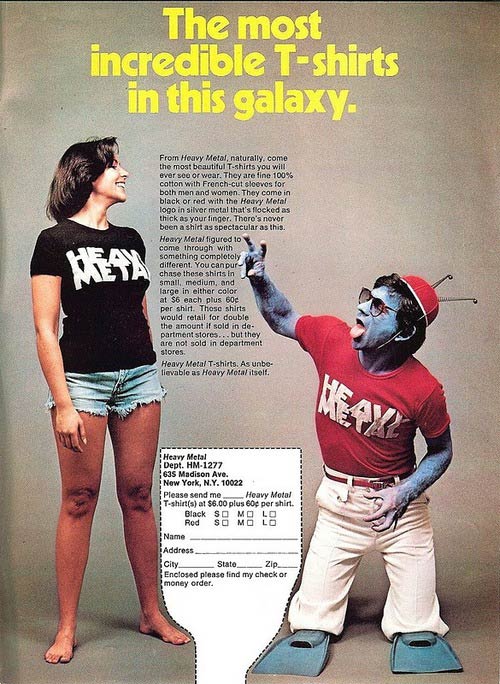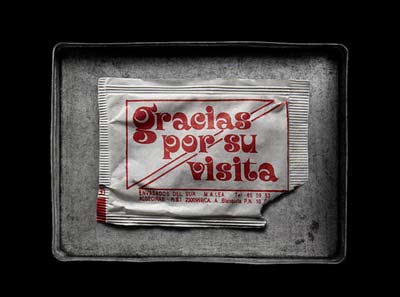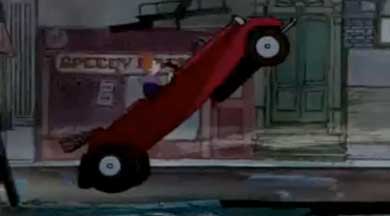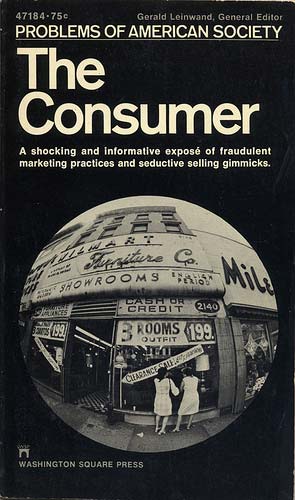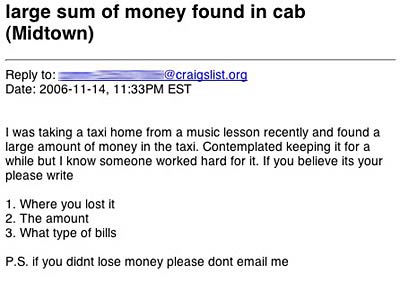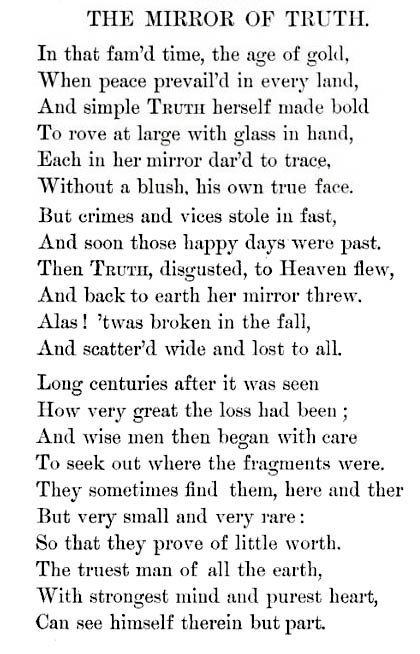 Naked woman tied to tree in Tacoma Park not a problem. Police officers talked with the woman and a man and determined it was a “consensual rendezvous.”
Naked woman tied to tree in Tacoma Park not a problem. Police officers talked with the woman and a man and determined it was a “consensual rendezvous.”
Woman sells ghosts for £1,300 in online auction.
Lindsay Lohan sued E*Trade Financial Corp for $100 million, saying a “milkaholic” baby girl who appeared in a recent commercial was modeled after her.
A Pittsburgh-area woman is suing Bank of America, claiming it wrongfully repossessed her home and saying that a bank contractor trashed the house and took her parrot.
A South Korean couple left their baby daughter to starve to death at home while playing an Internet game which simulated child-rearing. The man aged 41 and his 25-year-old wife were arrested Thursday, five months after they reported the death of their three-month-old baby.
Self-described “militant atheist” in England convicted of religiously aggravated harassment after leaving a spoof ad for “No More Nails” glue with a smiling Jesus stuck to the cross in the prayer room of Liverpool’s John Lennon airport. [via copyranter]
Kentucky woman spirts breast milk on the face of a police officer after being arrested for public intoxication.
San Juan del Rio, Mexico official punished a teenage graffiti artist by spray-painting his buttocks. Mayor then fired the official because he should have notified the boy’s parents so they could pay for the damage, and not punish the teen personally.
Mystery solved. Giant asteroid killed the dinosaurs, say scientists.
A team from the BBC1 science programme built a car that runs on coffee, nicknamed Carpuccino. The team calculates the Carpuccino will do three miles per kilo of ground coffee - the equivalent of about 56 espressos per mile.
A soccer player died after being speared by a piece of the court’s wooden floor during a friendly match in southern Brazil.
They read “F/CTL PRIM 1 FAULT” and “F/CTL SEC 1 FAULT”. This somewhat cryptic shorthand suggest the pilots tried desperately to restart the flight computer. The last four minutes of Air France flight 447.
The man with the world’s longest ear hair. Related: Police said a cook put a body hair in the bagel sandwich of a police officer who had given him tickets in the past.
Cunt of the Week™: Sen. Roy Ashburn. With a staunch anti-gay rights voting record, Ashburn has come out as gay, only after being arrested for DUI upon leaving a popular gay nightspot in Sacramento.
What if senators represented people by income or race, not by state?
The call for gun owners to carry their guns openly…
 Recession slang. (Staycation, Recessionista, Permatemp…)
Recession slang. (Staycation, Recessionista, Permatemp…)
They saved the big banks but kind of lost the economy doing it.
The Greatest Trade Ever: How John Paulson Bet Against the Markets and Made $20 Billion by Gregory Zuckerman. The story of one man’s refusal to believe in the health of the housing boom tells us a great deal about the financial crisis.
Americans earned a chunk of disposable income in December and felt so good about it that they rewarded themselves with shopping.
California is doomed for two simple but profound reasons: the cost structure is too high for most businesses to survive, and a boom-dependent economy.
The recession has encouraged many to reconsider the joys of playing with cardboard and plastic pieces–Clue, Monopoly, Risk and the like.
Women who drink gain less weight.
The advantages of being helpless. Human brains are slow to develop–a secret, perhaps, of our success.
Emotional extortion: how adolesents can manipulate parents.
Scientific examination of the subject has found that as the use of porn increases, the rate of sex crimes goes down.
Sleep deprivation impairs emotion recognition. [Sleep and Neuroimaging Laboratory, Department of Psychology and Helen Wills Neuroscience Institute, University of California, Berkeley, CA]
Ultraviolet freckles start fish fights. Reef fishes recognize rivals’ discrete, discreet marks.
The world’s foremost lion expert reveals the brutal, secret world of the king of beasts.
New model captures spread of personal information through social networks.
Now, I am a virtual world person, obviously. I don’t see much distinction between the game worlds and the non-game ones like Second Life. Are virtual worlds over?
How will we learn to use the multi-touch interfaces of the future?
Popular Science puts entire scanned archive online, free.
If news, as a commodity purveyed by reporters, is coming to an end, when and how did it start?
Words like mother and love often appear on lists of beautiful English words. But so do defenestration and lollygag.
Jonathan Safran Foer’s contingent vegetarianism. The argument he presents for vegetarianism is meticulous, unsparing and unusually powerful in its literary expression. More: Somewhere along the way, Jonathan Safran Foer or his publishers must have realized that the case he makes against American animal farming doesn’t apply tidily to Britain.
Over the years, Ulysses, though read only in its early fractions, had established itself as part of our literary life to come, when and if eventually completed and published. Books and their makers: Sylvia Beach and James Joyce.
 Thomas Hobbes saw the strife and murderous contention of 17-century Europe and developed a set of ideas for securing safety and order in modern societies. Moderns have always viewed Hobbes with morbid fascination. His absolutism seems vicious now, but his rationalized account of sovereignty has influenced us profoundly.
Thomas Hobbes saw the strife and murderous contention of 17-century Europe and developed a set of ideas for securing safety and order in modern societies. Moderns have always viewed Hobbes with morbid fascination. His absolutism seems vicious now, but his rationalized account of sovereignty has influenced us profoundly.
For those who lack a natural fondness for abstractions, philosophy is a discipline best experienced in bite-sized pieces.
Four philosophers accept our New Year’s challenge and attempt to answer the age old question, What is the meaning of life?
Some 6,500 writers, from Thomas Pynchon to Jeffrey Archer, have opted out of Google’s controversial plan to digitise millions of books.
Ryszard Kapuscinski said he knew Che Guevara. He recounted how he met Patrice Lumumba. But according to a new biography, his books were more fiction than fact.
6 insane coincidences you won’t believe actually happened.
In London on March 19, the international auction house Phillips de Pury plans to explore the interplay of contemporary art and sexuality with works that challenge our concepts of gender, sexual imagery and desirability.
Recent sales of contemporary art reveal a vibrant yet capricious rebound.
China’s art market is getting bigger all the time, at the expense of America and Britain.
Art attacks: From vomiting on Mondrian to elbowing a Picasso.
A major retrospective of Chris Ofili’s work at Tate Britain. Evolution from shape-shifter and provocateur to raw, open talent. More: The art world no longer wonders what to make of Chris Ofili’s dung-pocked canvasses. Instead, they wonder what he will make next.
Skateboards now hang in galleries, but are they wheelie art? Alex Castañeda hasn’t had much luck selling his oil-on-canvas paintings of police officers or old men playing guitars. But when he painted corpulent female nudes on the bottom of skateboards, they sold out at a local gallery near his home in Lima, Peru. And he received multiple orders from the U.S. and Canada through the Internet.
Our new installation Feel It, Take It is composed of 140 distinct cnc-cut recycled felt scarves designed to nest together and transform into a dense wool chandelier.
Richard Hamilton’s manipulations of news photographs show just how tricky taking a moral stance in art can be.
How do other people deal with the torrent of information that pours down on us all?
Music often fills me with the feeling that I care about certain things. Idealistic songs make me feel like I will go out and support some cause or another. Romantic songs make me feel that I would do just about anything for someone.
For parents, a hard lesson on drugs.
Survival tips from a Baghdad taxi driver.
The 10 most addictive sounds in the world.
My insomnia always begins with me falling asleep. And then, just as my mind turns itself off, I twitch awake.
My husband has cancer: Should I break off my affair?
 Why a Big Mac costs less than a salad.
Why a Big Mac costs less than a salad.
Lard: The new health food? Startled by news about the dangers of trans fats, writer Pete Wells happily contemplates the return of good old-fashioned lard.
High in protein, low in fat, delicious: why not eat bugs?
Although San Francisco is regarded as one of the most exciting dining destinations in America, The Castro is not a neighborhood that often comes to mind. Just a few blocks from the epicure Mission district, in a quiet, dark corner of 17th street, is a newly opened neighborhood restaurant that promises to light up the local dining scene. Food blog: No salad as a meal.
Would you live in these abandoned mental hospitals?
Top 5 toys for spoiled children.
Organic Architect Robert Oshatz’s Wowsa Wilkinson Treehouse.
Below are groups of digits whose calculator versions all have a particular property (or alternatively, do not have a property that all the other digits have). You have to figure out the characteristic property that the numbers in each group have (or don’t have).
The Sherlock Holmes Pipe Club, Boston. [Thanks Chris!]
GTL.
Welcome to my site! I am a true mid-west girl! Modeling is something that has become one of my true passions.


